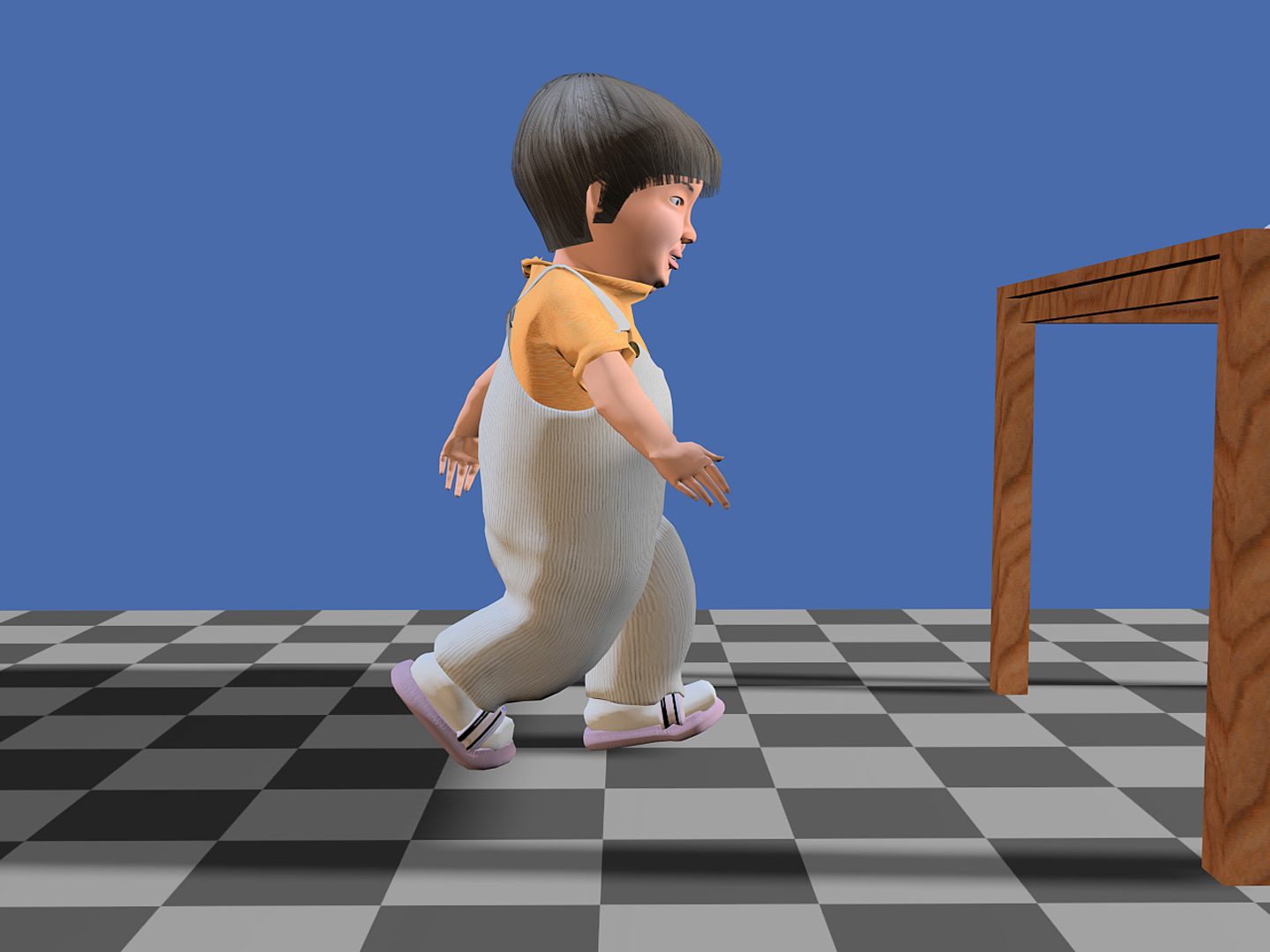“Obscuring length changes during animated motion” by Harrison, Rensink and Panne
Conference:
Type(s):
Title:
- Obscuring length changes during animated motion
Presenter(s)/Author(s):
Abstract:
In this paper we examine to what extent the lengths of the links in an animated articulated-figure can be changed without the viewer being aware of the change. This is investigated in terms of a framework that emphasizes the role of attention in visual perception. We conducted a set of five experiments to establish bounds for the sensitivity to changes in length as a function of several parameters and the amount of attention available. We found that while length changes of 3% can be perceived when the relevant links are given full attention, changes of over 20% can go unnoticed when attention is not focused in this way. These results provide general guidelines for algorithms that produce or process character motion data and also bring to light some of the potential gains that stand to be achieved with attention-based algorithms.
References:
1. CAVANAGH, P., LABIANCA, A. T., AND THORNTON, I. M. 2001. Attention-based visual routines: sprites. Cognition 80, 1–2, 47–60.Google ScholarCross Ref
2. COREN, S., WARD, L. M., AND ENNS, J. T. 1994. Sensation and Perception, 4th ed. Fort Worth: Harcourt Brace.Google Scholar
3. FRANCONERI, S. L., AND SIMONS, D. J. 2003. Moving and looming stimuli capture attention. Perception & Psychophysics 65, 7, 999–1010.Google ScholarCross Ref
4. GYSEN, V., DE GRAEF, P., AND VERFAILLIE, K. 2002. Detection of intrasaccadic displacements and depth rotations of moving objects. Vision Research 42, 379–391.Google ScholarCross Ref
5. HE, S., CAVANAGH, P., AND INTRILIGATOR, J. 1997. Attentional resolution. Trends in Cognitive Science 1, 3 (June), 115–120.Google ScholarCross Ref
6. HODGINS, J. K., O’BRIEN, J. F., AND TUMBLIN, J. 1998. Perception of human motion with different geometric models. IEEE Transactions on Visualization and Computer Graphics 4, 4, 17–25. Google ScholarDigital Library
7. HORVITZ, E., AND LENGYEL, J. 1997. Perception, attention, and resources: A decision-theoretic approach to graphics rendering. In Proceedings of the 13th Conference on Uncertainty in Artificial Intelligence, Association for Uncertainty in AI (AUAI), 238–249. Google ScholarDigital Library
8. KAERNBACH, C. 2001. Adaptive threshold estimation with unforced-choice tasks. Perception & Psycholophysics 63, 8, 1377–1388.Google ScholarCross Ref
9. KOVAR, L., SCHREINER, J., AND GLEICHER, M. 2002. Footskate cleanup for motion capture editing. In ACM SIGGRAPH Symposium on Computer Animation, ACM SIGGRAPH, 97–104. Google ScholarDigital Library
10. MOORE, C. M., AND WOLFE, J. M. 2001. Getting beyond the serial/parallel debate in visual search: a hybrid approach. In The Limits of Attention: Temporal Constraints in human Information Processing. Oxford: Oxford University Press, ch. 9, 178–198. Kimron Shapiro (Ed.).Google Scholar
11. MOZER, M. C., AND SITTON, M. 1998. Computational modeling of spatial attention. In Attention, H. Paschler, Ed. London: UCL Press, 341–393.Google Scholar
12. OESKER, M., HECHT, H., AND JUNG, B. 2000. Psychological evidence for unconscious processing of detail in real-time animation of multiple characters. J. Visualization and Computer Animation 11, 105–112.Google ScholarCross Ref
13. OLIVA, A., TORRALBA, A., CASTELHANO, M. S., AND HENDERSON, J. M. 2003. Top-down control of visual attention in object detection. In Proceedings of the IEEE International Conference on Image Processing, vol. 1, 253–256.Google ScholarCross Ref
14. O’SULLIVAN, C., AND DINGLIANA, J. 2001. Collisions and perception. ACM Transactions on Graphics 20, 3, 151–168. Google ScholarDigital Library
15. O’SULLIVAN, C., DINGLIANA, J., GIANG, T., AND KAISER, M. K. 2003. Evaluating the visual fidelity of physically based animations. In Proceedings of ACM SIGGRAPH 2003, ACM Press / ACM SIGGRAPH, 527–526. Google ScholarDigital Library
16. PYLYSHYN, Z. W., AND STORM, R. W. 1988. Tracking multiple independent targets: Evidence for a parallel tracking mechanism. Spatial Vision 3, 179–197.Google ScholarCross Ref
17. REITSMA, P. S. A., AND POLLARD, N. 2003. Perceptual metrics for character animation: Sensitivity to errors in ballistic motion. In Proceedings of ACM SIGGRAPH 2003, ACM Press / ACM SIGGRAPH: New York, ACM SIGGRAPH, 537–542. Google ScholarDigital Library
18. RENSINK, R. A. 2002. Change detection. Annual Review of Psychology 53, 245–277.Google ScholarCross Ref
19. SEKULER, R., WATAMANIUK, S. N. J., AND BLAKE, R. 2002. Perception of visual motion. In Stevens Handbook of Experimental Psychology, 3rd ed., vol. 1. New York: Wiley, ch. 4.Google Scholar
20. SIMONS, D. J., AND CHABRIS, C. F. 1999. Gorillas in our midst: Sustained inattentional blindness for dynamic events. Perception 28, 1059–1074.Google ScholarCross Ref
21. SIMONS, D. J., FRANCONERI, S. L., AND REIMER, R. L. 2000. Change blindness in the absence of visual disruption. Perception 29, 1143–1154.Google ScholarCross Ref
22. TAYLOR, M. M. 1967. Pest: Efficient estimates on probability functions. Journal of the Acoustical Society of America 41, 4, 782–787.Google ScholarCross Ref
23. TOMAT, L., SCAMARDI, P., AND VICARIO, G. B. 1999. The perception of length changes in moving objects. Presented at ECVP’99.Google Scholar
24. VERSTRATEN, F. A., CAVANAGH, P., AND LABIANCA, A. T. 2000. Limits of attentive tracking reveal temporal properties of attention. Vision Research 40, 3651–3664.Google ScholarCross Ref




